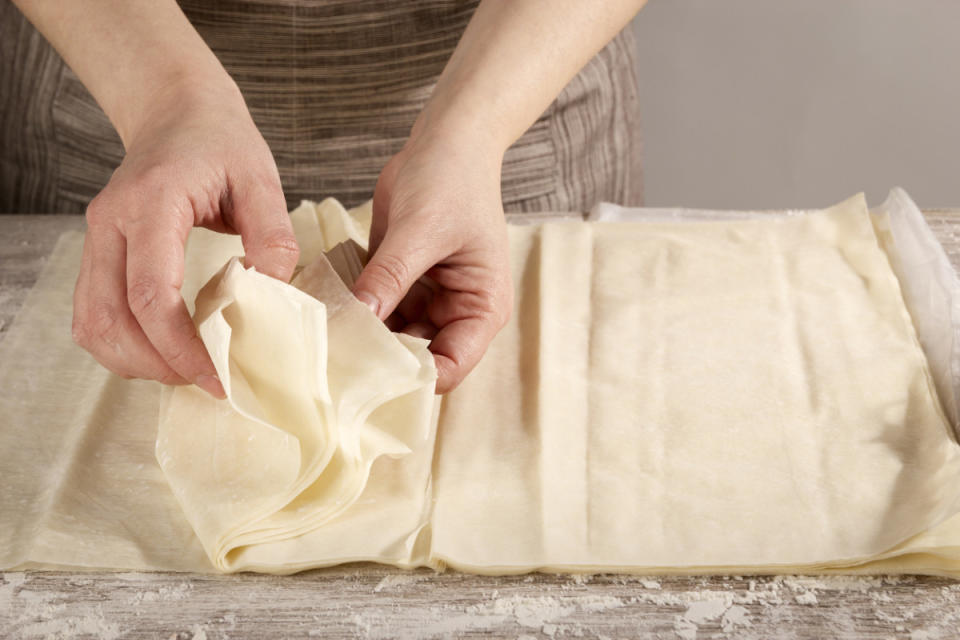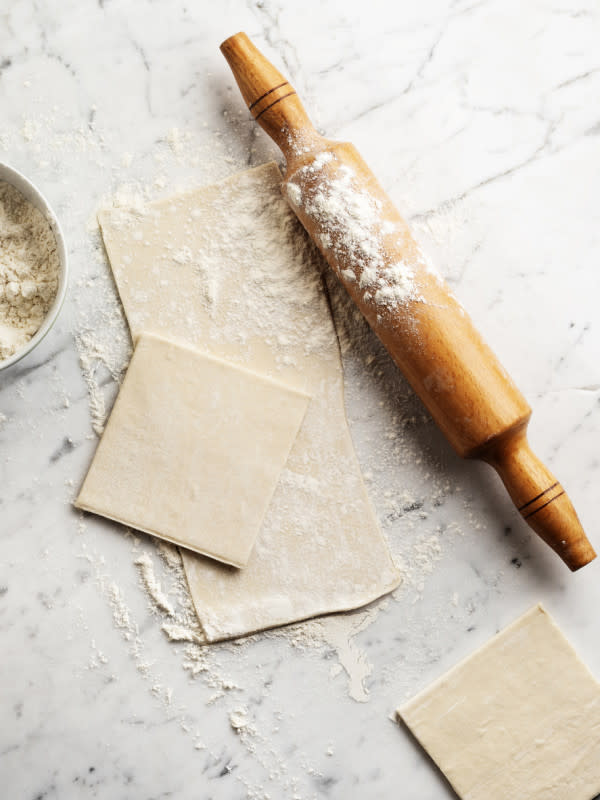Wait, What's The Difference Between Phyllo Dough and Puff Pastry?

Pastries made with phyllo dough and puff pastry
Puff pastry and phyllo (alternatively spelled “filo” or “fillo” and often referred to as ”phyllo dough” on store-bought packages) are both doughs that can be used in sweet and savory applications to yield tasty layered dishes, but it’s their particular styles of flakiness that make them unique.
You'll often find both doughs in the same section of the freezer aisle in the grocery store, which just adds to the confusion, leaving you standing in the store wondering what's the difference between phyllo and puff pastry. To help you decide which one you need for the recipe you're making, we did a deep dive into both flaky doughs so you'll know which is which once and for all. Here's what you need to know about phyllo vs. puff pastry.

iStock
What is Phyllo?
Phyllo is a type of unleavened dough typically made from flour, water, oil and a bit of vinegar (depending on the recipe) that is rolled and stretched into paper-thin sheets. While phyllo is often associated with certain cuisines and cultures (such as Greek, Middle Eastern, and Turkish), its exact origins are blurry, both unclear and often disputed. The name “Phyllo” (as it’s most commonly referred to in the US), comes from the Greek word for “leaf,” and refers to the thinness of the sheets of dough.
Phyllo is used in savory and sweet dishes, but you might have had it in baklava, where the layers are sometimes less crisp because of a honey soak. It's also the pasty that's used to make those cute fluted pastry cups that you might have seen in the freezer section. On the savory side, phyllo is used to make spinach-packed spanakopita and Middle Eastern b?rek.
You can make phyllo at home, but because of the delicate nature and time it takes to stretch the dough to the correct thinness, most recipes using phyllo often opt for the store-bought option.
The process for using phyllo, though it can vary slightly between recipes, is often similar: If using store-bought sheets, thaw if frozen, then unroll or unfold the sheets flat. Keep the sheets covered with a damp cloth or paper towel to prevent them from drying out. Place one sheet on your work surface, keeping the rest covered, and brush the sheet with melted butter (or another liquid fat). Place another sheet on top and continue brushing each layer until you have the thickness you're going for. This process of layering the paper-thin sheets with melted butter is what creates those shatteringly crisp, flaky layers when baked.
Related: 23 Phyllo Cup Recipes That Work For Any Occasion

iStock
What is Puff Pastry?
If you've had a French tarte tatin, an apple turnover, heart-shaped palmiers, pastry-wrapped baked brie or beef wellington then you've likely had puff pastry. Puff pastry dough (“pate feuilletée” in French) uses the lamination method to create buttery, flaky pastry. Traditionally, the process for making puff pastry is similar to that of laminating croissants. However, whereas croissant dough is yeasted, puff pastry is not. Moreover, puff pastry dough has cubes of cold butter cut into the flour mixture (similar to pie dough and biscuits), as well as a butter block.
It's possible to make puff pastry at home, but it requires some time and patience—and a lot of butter. First, the dough is made (with the aforementioned cubes of butter cut in) and chilled. The dough then gets rolled out and wrapped around a butter block. After chilling to make sure the dough and butter reach the same malleable texture, this slab of dough-wrapped butter is rolled, folded and turned (chilling in the fridge between each) to create layer upon layer of dough and butter. When baked, the heat of the oven turns the water in the chilled butter to steam, pushing the layers of dough apart to (quite literally) create a puffed pastry that’s buttery, lofty, light and flaky.
For a less labor-intensive puff pastry, you can try the blitz method, which is also known as "rough puff," for any GBBO fans. For rough puff, you skip the butter block, relying only on the butter that gets cut into the flour mixture and a series of folds and turns to create the pastry’s layers. Because this method is slightly less arduous than the more classic method, it’s a great option for home bakers and cooks who want to make their own puff pastry, but don’t have as much time.
The third and easiest option is picking up a box of frozen puff pastry at the grocery store. Store-bought puff pastry is not only convenient but it's also delicious and incredibly easy to use. It's typically sold frozen, so just thaw, carefully unfold, and use as directed in the recipe.
Related: 36 Savory and Sweet Recipes Starring Puff Pastry
Using Phyllo and Puff Pastry
While both phyllo and puff pastry yield lots of shattering layers when baked, their textures are very different. Baked puff pastry is noticeably lofty, airy, and delicate with a browned crust. When baked, phyllo's layers are light and quite close together and so crisp it shatters. Phyllo dough also has a less rich flavor because it's not made with butter. Because of these differences in texture and flavor, the two can't be interchanged to yield the same results.
If you’re new to using phyllo, puff pastry, or both, here are a few recipes to get you started.
Phyllo Dough Recipes to Try
? Tik-Tok Famous Phyllo Crinkle Cake
? Peachy Brie Bites
? Martha Stewart's Vegetable Barley Pot Pies
? Creamy Pea and Scallion Phyllo Cups
Puff Pastry Recipes to Try
? The Best Baked Brie
? Tik-Tok Famous Upside-Down Pastries
? Easy, Elegant Parmesan Puff Pastry Straws
? Asparagus, Tomato and Cheese Tart
